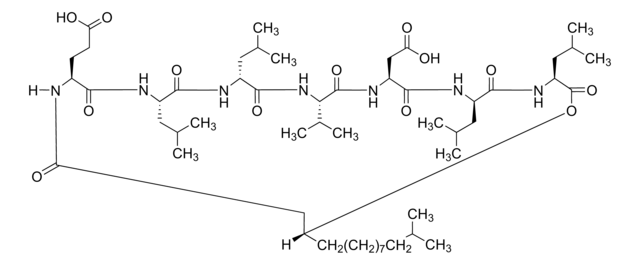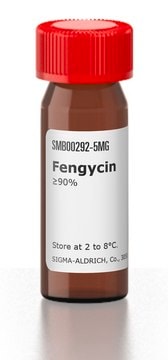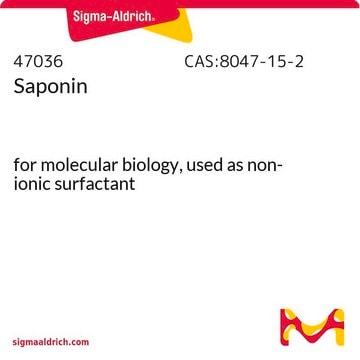추천 제품
product name
Rhamnolipids, 90%,
생물학적 소스
Pseudomonas aeruginosa
Quality Level
형태
solid/granular
환경친화적 대안 제품 특성
Design for Degradation: Greener alternative product characteristics
Learn more about the Principles of Green Chemistry.
sustainability
Greener Alternative Product
환경친화적 대안 카테고리
, Aligned
배송 상태
ambient
저장 온도
room temp
유사한 제품을 찾으십니까? 방문 제품 비교 안내
일반 설명
Rhamnolipid biosurfactants are glycolipids containing L-rhamnose and ß-hydroxyl fatty acids, with amphiphilic properties (both hydrophilic and hydrophobic). This rhamnolipid product has been purified from Pseudomonas aeruginosa and contains a mixture of rhamnolipids with fatty acids of varying tail length. They are highly biodegradable, non-toxic, and renewable. Functional roles include bioactive, surfactant and emulsifier. Rhamnolipids provide good detergency/foaming/wetting, stable microemulsion formation, and solubility under high alkalinity. They are mild with skin-friendly attributes. Surfactant and emulsion properties of rhamnolipids include reducing the surface tension of water to 25 to 40 mN/m, having a CMC of 5-380 mg/L, and decreasing the interfacial tension of oil and water to <1 dyne/cm. Rhamnolipid biosurfactants are superior to synthetic surfactants for several reasons: their CMC is 10-100 times lower than that of traditional chemical surfactants (meaning much less material is required to achieve reductions in surface tension/interfacial tension); they are easily biodegradable with very low toxicity (having higher EC50 values); they are not as affected by temperature, pH and salinity; and they are sustainably produced.
We are committed to bringing you Greener Alternative Products, which adhere to one or more of The 12 Principles of Greener Chemistry. This product has been enhanced for hydrocarbon degradation. For more information see the paper Environmental applications of biosurfacants: recent advances, and the many other articles available at: AGAE Technologies
We are committed to bringing you Greener Alternative Products, which adhere to one or more of The 12 Principles of Greener Chemistry. This product has been enhanced for hydrocarbon degradation. For more information see the paper Environmental applications of biosurfacants: recent advances, and the many other articles available at: AGAE Technologies
애플리케이션
Rhamnolipids can be used in pharmaceuticals, cosmeceuticals, cosmetics, personal products, environmental bioremediation, the petroleum industry, household cleaners, food and beverage processing, agriculture and horticulture, therapeutics, nanotechnology, the polymer industry, cryo-protectants, the mining industry, biofuels, ethanol production, microbial fuel cells, protein research, and neural stem cell studies.
법적 정보
Product of AGAE Technologies
Storage Class Code
11 - Combustible Solids
WGK
WGK 3
Flash Point (°F)
Not applicable
Flash Point (°C)
Not applicable
시험 성적서(COA)
제품의 로트/배치 번호를 입력하여 시험 성적서(COA)을 검색하십시오. 로트 및 배치 번호는 제품 라벨에 있는 ‘로트’ 또는 ‘배치’라는 용어 뒤에서 찾을 수 있습니다.
Ibukun O Olasanmi et al.
Journal of advanced research, 21, 79-90 (2020-02-20)
Environmental pollution by petroleum hydrocarbons (PHCs) is a severe and widespread problem impacting human health and the environment. To combat this issue, innovative and sustainable treatment methods are required. This research study investigated rhamnolipid-enhanced washing of drill cuttings and petroleum-contaminated
Irene E Samonte-Padilla et al.
BMC developmental biology, 11, 55-55 (2011-09-14)
Rapid advances in genomics have provided nearly complete genome sequences for many different species. However, no matter how the sequencing technology has improved, natural genetic polymorphism complicates the production of high quality reference genomes. To address this problem, researchers have
Bartosz Gerard Gdaniec et al.
Environmental microbiology, 22(8), 3572-3587 (2020-06-24)
Interspecies bacterial competition may occur via cell-associated or secreted determinants and is key to successful niche colonization. We previously evolved Pseudomonas aeruginosa in the presence of Staphylococcus aureus and identified mutations in the Wsp surface-sensing signalling system. Surprisingly, a ΔwspF
[Factor VIII inhibitor postpartum].
I Ohkubo et al.
[Rinsho ketsueki] The Japanese journal of clinical hematology, 27(9), 1596-1602 (1986-09-01)
Roger Marchant et al.
Biotechnology letters, 34(9), 1597-1605 (2012-05-24)
Glycolipid biosurfactants produced by bacteria and yeasts provide significant opportunities to replace chemical surfactants with sustainable biologically produced alternatives in bulk commercial products such as laundry detergents and surface cleaners. Sophorolipids are already available in sufficient yield to make their
자사의 과학자팀은 생명 과학, 재료 과학, 화학 합성, 크로마토그래피, 분석 및 기타 많은 영역을 포함한 모든 과학 분야에 경험이 있습니다..
고객지원팀으로 연락바랍니다.







